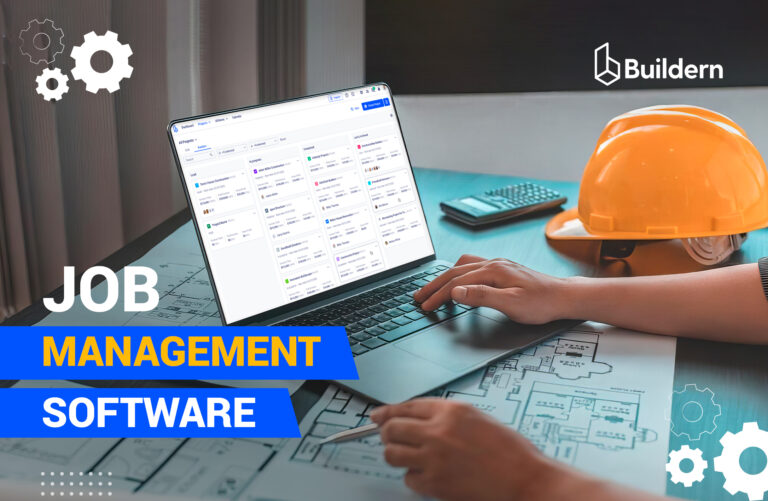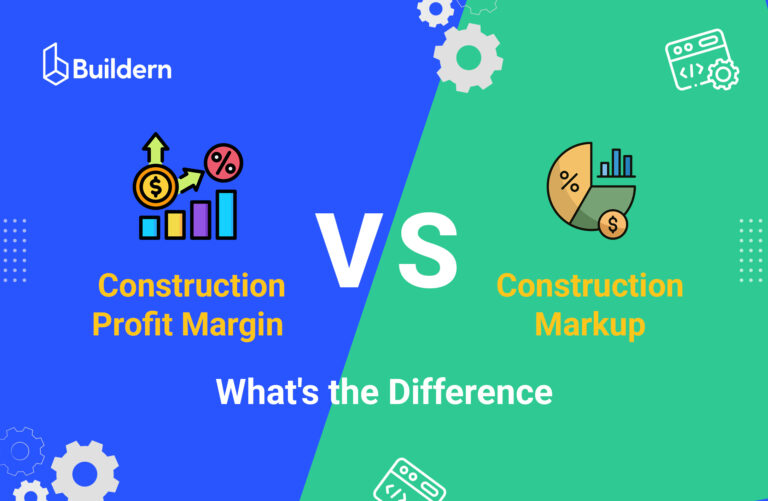11 Best Construction Scheduling Software Reviewed [2025 Edition]
![11 Best Construction Scheduling Software Reviewed [2025 Edition]](https://buildern.com/resources/wp-content/uploads/2023/04/Construction-Scheduling-Software-768x501.jpg)
Last update August 2025
Struggling to keep your construction projects on schedule and within budget?
You’re not alone. With the growing complexity of construction projects, managing schedules, resources, and budgets has become a major challenge for construction managers. Fortunately, there’s a solution: finding a perfect construction scheduling software platform to manage it all.
These tools streamline the project management process, making it easier to stay on top of schedules, track progress, and identify potential roadblocks before they happen.
In this article, we’ll be discussing the top 11 construction scheduling software options for 2023, helping you find the best fit for your organization and improve your project management efforts.

Table of Contents
- Buildern
- ProjectManager
- GanttPRO
- Microsoft Project
- Archdesk
- Smartsheet
- e-Builder
- Wrike
- Assignar
- Jobber
- Float
Buildern: Construction Scheduling Software and Beyond!
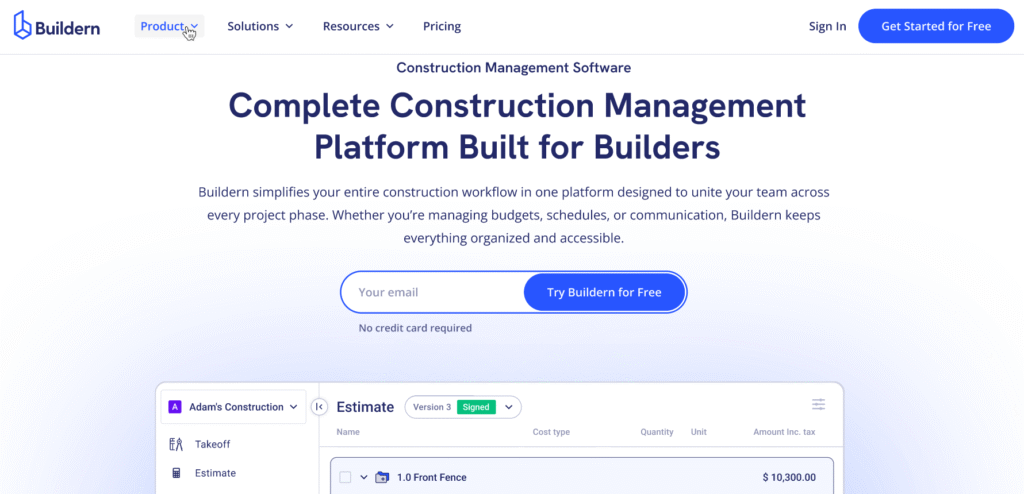
Buildern is a comprehensive construction estimating and project management software with scheduling, CRM, and other capabilities designed specifically for the construction industry. The software’s focus on customization and adaptation sets it apart from other scheduling solutions on the market.
You are free to choose between three schedule views: Gantt charts, list, and calendar to get a complete and multi-level picture of your project’s progress.
The Gantt charts are a powerful tool for visualizing schedules. This view displays all tasks as bars on a timeline, providing a clear representation of the project schedule. The system displays dependencies between tasks as arrows, making it easy to understand how changes to one task can impact the rest of the project. This allows Buildern users to set the relationships between different tasks accurately, while controlling the project workflow even when change orders arrive.
Our construction schedules have four types of dependencies:
- Finish-to-start
- Start-to-finish
- Start-to-start
- Finish-to-finish
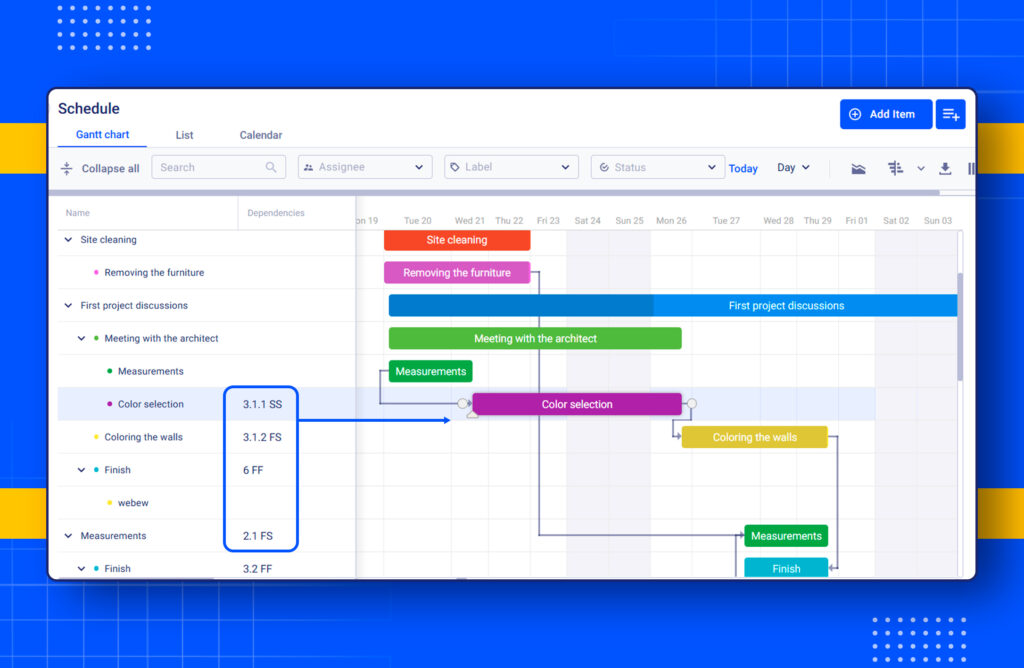
Another standout feature of Buildern’s scheduling capabilities is its drag-and-drop editor, which allows users to quickly and easily make changes to their schedules. Workday exceptions can be configured, ensuring that schedules take into account weekends, holidays, and other non-working days.
The software also offers a critical path analysis, providing a visual representation of the longest path of dependent tasks, which helps teams identify potential bottlenecks and adjust schedules accordingly.
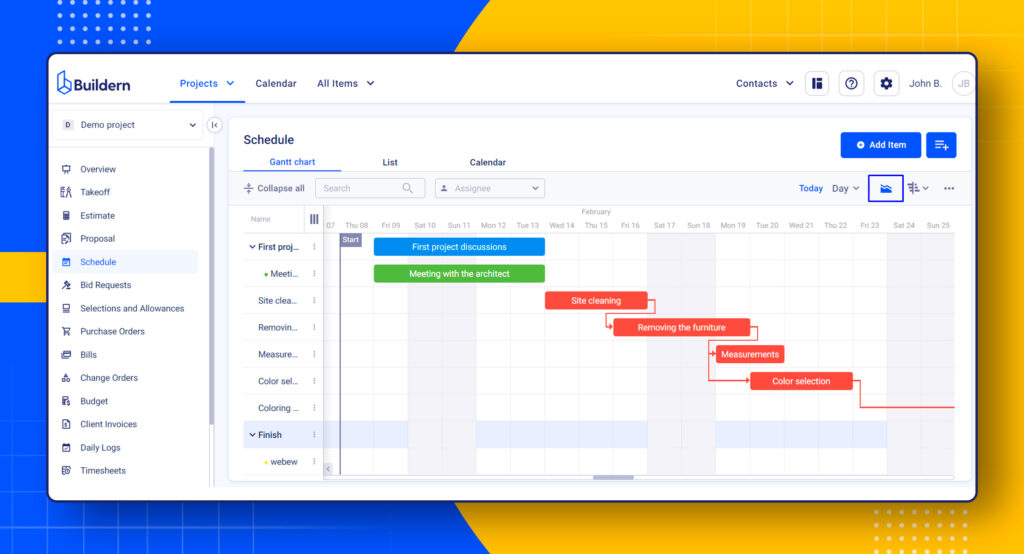
The ability to configure a working calendar and set baselines makes it easy to track progress and ensure that projects stay on track.
But that’s just a small part of Buildern’s scheduling and project planning capabilities. Here’s what else you’ll get:
Key Features
- Gantt Charts: Buildern’s Gantt charts are a powerful tool for visualizing schedules, making it easy to understand project progress.
- Calendar Configuration: Buildern simplifies project planning, allowing builders to set working hours, define public holidays, and working and non-working days. Automatically defining Saturdays and Sundays as non-working days, this construction scheduling software makes precise calculations regarding each task and project duration.
- Smart Notification System: Keep your team updated in real time with smart notifications for all the changes happening to the schedule. You can keep the communication via a dedicated messaging platform integrated to your Buildern account or stick to emails, resting assured that all the conversations will be stored securely in your account.
- Reusable Templates: Create schedules with premade templates from other projects and convert the estimate line items into simple schedule blocks.
- Cloud-Based Access: Access all your project data anytime and anywhere with information stored in a secure cloud.
- Critical Paths: Identify critical paths, prioritizing tasks that have the greatest impact on project timelines and budgets. This will immensely reduce the risk of costly delays.
- Baselines: Through the flexible user interface, Buildern will show the original start and due dates for each project. This feature helps builders identify the current progress against original timelines and make necessary adjustments to ensure each deliverable corresponds to the deadlines.
Pricing
Buildern offers three pricing options for its construction scheduling software: starter, professional, and enterprise.
- The starter plan is $225/month, billed annually, and includes all the essential feature packs required to manage multiple projects, enabling access to advanced reporting.
- The professional package is priced at $360/month, billed annually. It includes all features available in the starter option, as well as premium features such as custom branding, integrations with other tools, and priority support.
- The enterprise package users are welcome to contact our sales team to discuss the terms and conditions based on their corporate needs.

With three options to choose from, Buildern provides construction companies of all sizes with the ability to find the right pricing option to fit their expectations and budget. The starter plan with a free trial is a great way for users to test out this construction scheduling software and see if it fits their needs, while the professional and enterprise options provide more advanced features for organizations looking for a comprehensive construction project management solution.
ProjectManager
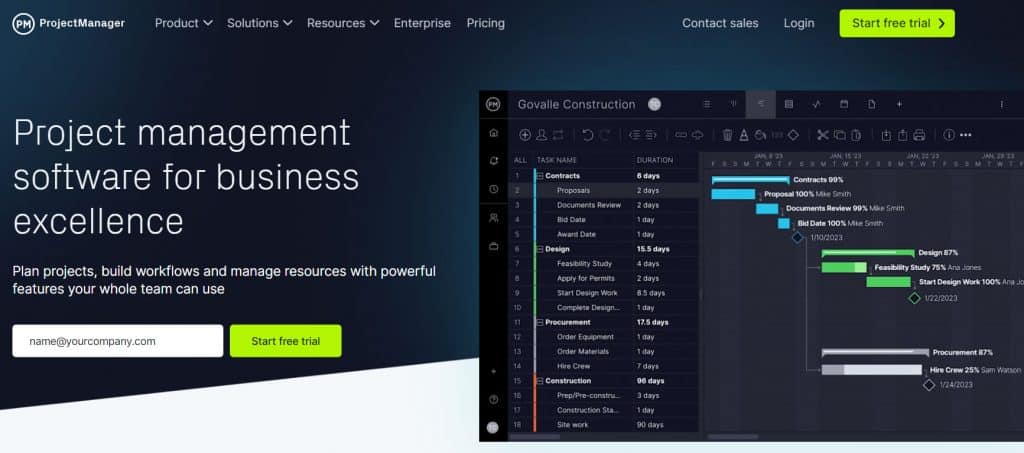
ProjectManager is a cloud-based project and portfolio management platform built for teams in demanding environments, especially construction and capital projects. Its interface blends flexible Gantt charts, task lists, kanban boards, calendars, and real-time dashboards into a cohesive scheduling ecosystem that teams can adopt quickly.
Beyond visual scheduling, ProjectManager adds operational depth: crews can submit timesheets that flow into budget dashboards. Its resource management tools allow planners to balance capacity and track availability.
Pros
- Users praise its usability and fast onboarding, making scheduling accessible to teams.
- The blend of views (Gantt, list, board, calendar) with built-in timesheets and budgets delivers real-time performance insight.
- The mobile app supports field-to-office coordination, and automation features reduce repetitive work.
Cons
- Some users find the feature set initially overwhelming, especially teams used to lighter tools.
- The mobile experience doesn’t fully match desktop capability, at times lagging or stripped down.
- Reporting templates and visual options are functional but could be more customizable and visually rich.
- Several reviews highlight poor communication around trial expirations (non-cancellation resulting in charges), as well as frustrating customer support and billing practices.
Pricing
- Team: ~$14/user/month (annually billed) or ~$17/month; includes Gantt, Kanban, timesheets, dashboards, up to 20 projects, 5 GB storage, mobile apps, API, SSO.
- Business: ~$26/user/month (annually) or ~$30/month; adds resource management, workload planning, budgeting, advanced reporting, portfolio dashboard, risk tools, automation (5 rules), 25 GB storage.
- Enterprise: Custom pricing that includes unlimited projects/storage, unlimited guests, SSO, audit logs, custom roles, priority onboarding/support, and extended automation rules.
GanttPRO
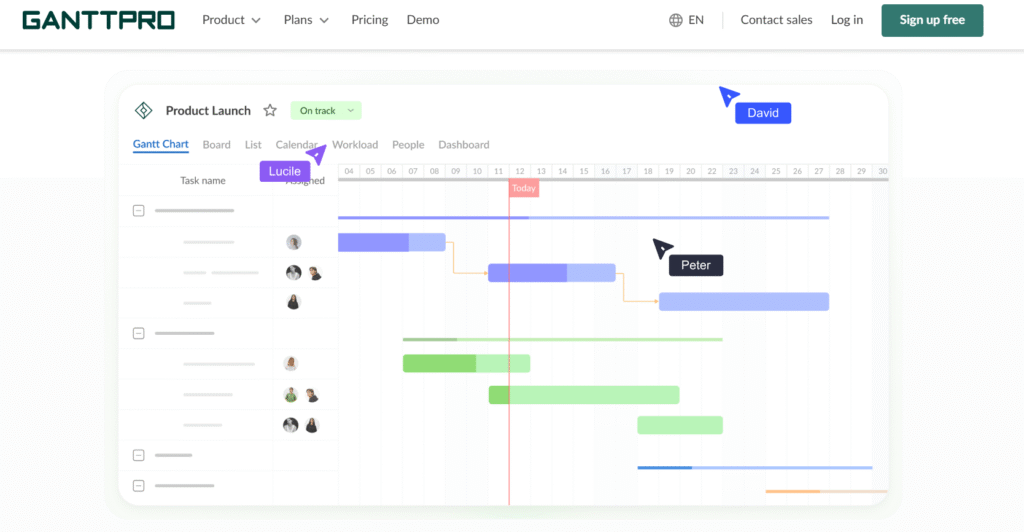
GanttPRO is a cloud-based project management tool that helps project managers and teams plan, manage, and track their projects. The tool offers a user-friendly interface with drag-and-drop functionality to create, assign, and track tasks, set deadlines, and track progress in real-time. GanttPRO provides a Gantt chart view that visually represents project timelines, dependencies, milestones, and critical paths, making it easy for project managers to manage complex projects.
It’s especially appealing to mid‑size builders and subcontractors who need fast schedule visibility without the overhead of heavyweight systems. GanttPRO supports budget tracking, workload balancing, import/export from platforms like Excel or MS Project, and offers templates optimized for construction workflows.
In addition, GanttPRO offers features such as team collaboration, resource allocation, time tracking, progress tracking, and reporting. The tool also offers customizable Gantt chart views, project templates, and integration with other project management tools. The cloud-based feature allows users to access their projects from anywhere, and team members can collaborate in real time.
Pros
- User-friendly interface: Users rave about how easy it is to “move projects along the timeline” and maintain control via a clean, intuitive interface.
- Gantt chart view: The tool offers a Gantt chart view that helps project managers visualize project timelines, dependencies, milestones, and critical paths.
- Collaboration: Smart templates, real-time updates, public project links, and Excel/MS Project imports make coordination easier on and off site.
- Customizable: The tool allows users to customize the Gantt chart view to suit their specific project management needs.
- Integration: GanttPRO integrates with other project management tools, enabling users to manage their projects seamlessly across multiple platforms.
- Ranked for value: High Capterra ratings for value and ease of use including “Best Value” badges, indicate strong ROI for small to mid‑size teams.
Cons
- Online‑only: No offline mode; lack of internet access can prevent schedule updates. This is a concern for remote sites.
- Minor usability bugs: Some users report quirky behavior, like renaming tasks opening info panes unintentionally.
- Feature depth: While clean, the tool lacks broader PM functionality of full platforms like resource leveling, deeper reporting, or integrations beyond the basics.
- Pricing for larger teams: A few reviews observe that per‑user pricing can quickly climb for bigger crews some question cost scalability.
Pricing
- Core (formerly Basic): ~$7 per user/month (annually billed); includes Gantt, board, list views, and task management.
- Advanced (Pro-tier): ~$10 per user/month; adds calendar view, more task status/details.
- Business: ~$17 per user/month; adds dashboard, portfolio views, resource management, reporting, API, and integrations.
- Enterprise: Custom pricing; includes everything above plus SSO, audit logs, and priority support.
Microsoft Project
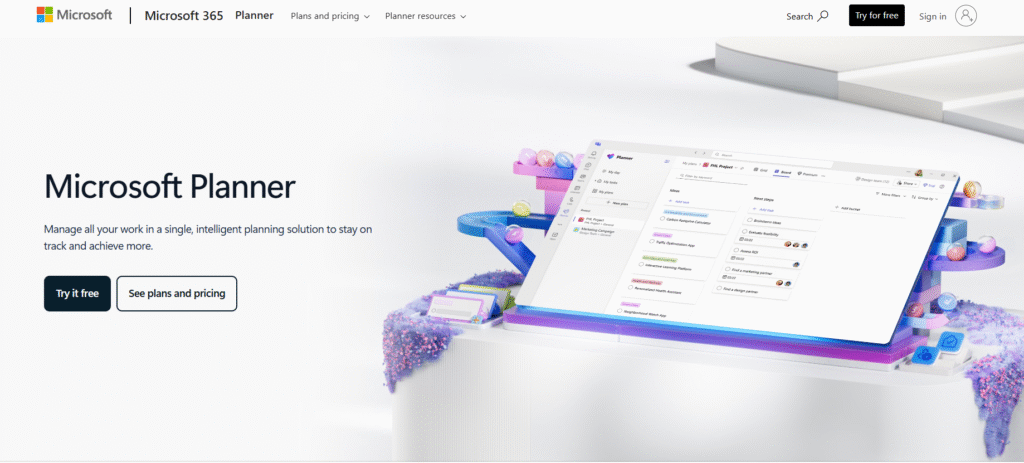
Microsoft Project is still the heavyweight option when a build needs strict critical‑path control, resource leveling, and multiple baselines. Schedulers use it to map task logic, set leads and lags, and measure variance against the plan. For firms already on Microsoft 365, it fits into the stack: reporting ties into Power BI, collaboration runs through Teams and SharePoint, and higher tiers include the classic Project Online desktop client for advanced CPM work and portfolio governance.
One key 2025 update: Microsoft is consolidating Project for the web into the new Planner experience. Microsoft has announced that Project for the web will retire on August 1, 2025, with capabilities migrating to Planner on the web and in Teams. If you previously used Project for the web, your licensing carries over, while the desktop client remains available in the higher “Planner + Project” plans. This matters for construction teams deciding between browser scheduling and desktop‑grade CPM.
Pros
- Handles large, CPM‑driven schedules with baselines, dependencies, and resource management; strong fit for organizations that need portfolio oversight.
- Integrates across Microsoft 365 for collaboration and reporting, which many teams already rely on.
- Reviewers highlight capacity planning, Gantt views, and Power BI connectivity as practical strengths.
Cons
- Steep learning curve: Microsoft Project can be complex, and it can take time to learn how to use the software effectively.
- Expensive: Some users call out cost and limited flexibility or customization compared with newer tools; a few note UX age and Mac/web limitations.
- Requires Microsoft Office: Microsoft Project requires a Microsoft Office subscription, which can be an additional expense.
Pricing
- Planner in Microsoft 365 is included with many Microsoft 365 plans. Premium tiers are:
- Plan 1: $10/user/month, Planner and Project
- Plan 2: $30/user/month, Planner and Project
- Plan 3: $55/user/month (annual billing).
Plan 3 and Plan 5 include Project Online and the Project Online desktop client. Always confirm regional pricing and taxes.
Archdesk
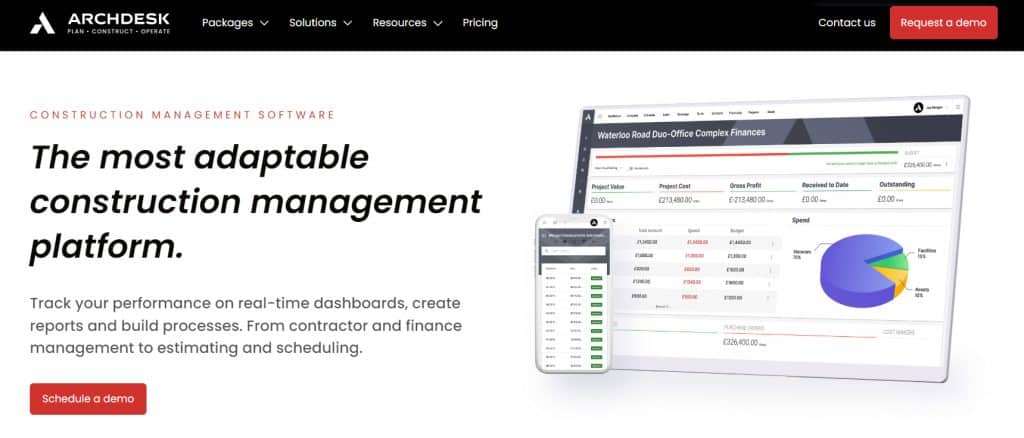
Archdesk is a construction project management software that is specifically designed for architecture and engineering firms. The tool includes modules for scheduling, cost control, estimation, procurement, document management, and real-time dashboarding, designed so that teams don’t have to stitch together multiple systems to run operations efficiently. Its scheduling features allow users to assign resources, define dependencies, detect clashes or non-working days, and offer a project map view enabling management of schedules across multiple sites and workflows.
The software is user-friendly and offers a centralized platform for all project-related information and activities. It aims to streamline construction processes, reduce administrative overhead, and improve overall project efficiency and productivity.
Pros
- Live projects map: Having a live projects map is a pro of Archdesk as it allows users to easily visualize the location of all current projects, which can be useful for project management purposes.
- Process page: The process page provides a comprehensive overview of the job status at any given time is another positive aspect of the tool.
- Unified construction-specific modules: combining scheduling, budgeting, documents, procurement, and more into a single interface makes cross-functional coordination smoother
Cons
- High entry cost: £690/month is a steep upfront investment, especially for small-to-mid firms evaluating ROI against more modular or entry-level systems.
- Lack of customization: Some users may find that the platform has limited customization options for setting up their company processes. This means that the platform may not be able to fully accommodate the unique needs and preferences of a particular organization, potentially leading to workarounds or inefficiencies in their workflow.
- Limited functionality in document/invoice workflows: This suggests lacking auto-send or proof-of-delivery features, which some users feel would improve client communication and administrative automation.
Pricing
- According to Capterra, Archdesk starts at £690 per month under a pricing model labeled “Basic,” with no free trial or version; custom plans available via contact.
- Software Advice reports the same starting price of £690/month, noting that pricing details and plan specifics are usually provided by request, often tailored based on team size and modules needed.
Smartsheet
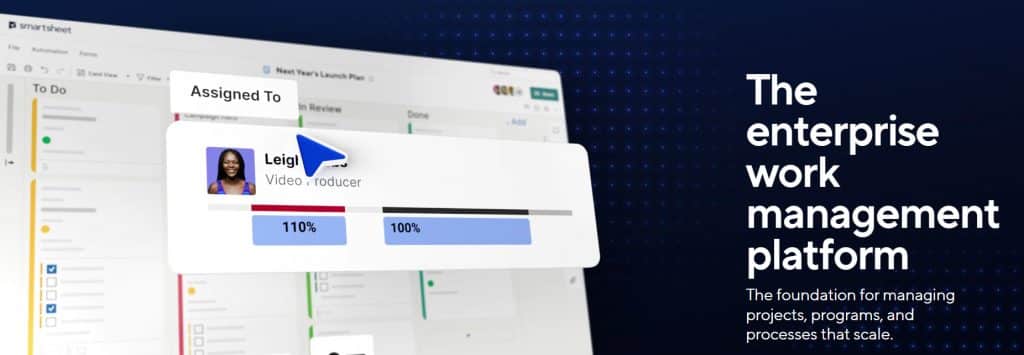
Smartsheet is a cloud-based project and work management tool that helps organizations and teams to plan, track, and manage their projects and tasks. It looks like a spreadsheet at first, which makes it less intimidating for crews who’ve always used Excel to track jobs. The difference is that you can turn those rows into Gantt charts, card views, or calendars with a couple of clicks.
It connects with the usual suspects Microsoft, Google, Slack, Salesforce so it slips into office workflows without much fuss. Still, this isn’t software written specifically for construction. You won’t find built-in RFI logs or punch lists, and setting up a polished dashboard takes patience. Some users also complain that when sheets grow heavy, they slow down. And if you’re rolling it out to big teams, the per-user pricing stacks up faster than expected.
Pros
- Spreadsheet familiarity: For many construction staff, this is huge. If you grew up with Excel, Smartsheet feels intuitive, not alien.
- Solid integration suite: Works with Microsoft 365, Google Workspace, Slack, Salesforce, and via Zapier to,o so it slots into workflows that already exist.
- Portfolio-level visibility: Dashboards can aggregate job status, recent changes, and spend performance helpful for executive teams overseeing multiple sites
Cons
- Learning Curve: Creating dashboards or automations is not plug-and-play. It’s a pace shift for teams used to Excel, and some struggle without hands-on training.
- Performance dips on big sheets: Smartsheet can bog down if you load it with thousands of rows or complex formulas especially problematic for remote sites on weak connections.
- Cost scales fast: $19/user/month sounds affordable until you roll it out across 50 people. Enterprise add-ons push it even higher. A hidden burden if you’re managing a large construction crew.
- Not construction-native: There’s no built-in RFI log or field punch-list template. Building those workflows can take time or require add-ons .
- Permissions are clunky: In big organizations, managing who sees what subs vs. PMs vs. clients can get messy. Smartsheet doesn’t make it easy out of the box.
Pricing
The entry tier, Pro, is about $9 per user/month when billed annually. It’s light but covers the essentials, grid and Gantt views, simple cards and calendars, plus a handful of automations. For many small teams, this is the starting point.
The next step up is the Business plan, priced at around $19 per user/month. This tier unlocks unlimited automations, baseline comparisons, proofing and review tools, 1 TB of storage, and custom branding. Most mid-sized construction companies tend to land here because it balances features with cost.
For larger firms, Enterprise pricing is only available by quote. Here, Smartsheet layers in stronger governance controls, single sign-on (SAML), integrations with Salesforce and Jira, and admin tools that aren’t included in lower tiers. It’s usually chosen by companies that need system-wide reporting and stricter compliance.
e-Builder

e-Builder is a web-based construction project management platform that provides a complete solution to manage all aspects of the building process. It helps construction firms to keep track of their project’s budget, timeline, subcontractors, procurement, safety, and other important factors.
The tool offers real-time information and analytics, project overviews, and automated procedures, allowing users to work together with project teams and other stakeholders.
Additionally, it features document control, communication management, and change order management tools. The goal of the software is to simplify construction procedures and enhance project completion.
Pros
- Cloud-based platform: e-Builder is a cloud-based platform, which provides users with accessibility to their project data and information from anywhere with an internet connection.
- Comprehensive solution: The tool provides a comprehensive solution for managing all aspects of a construction project, including budget, schedule, subcontractor management, procurement, and safety.
- Real-time data and analytics: e-Builder offers real-time data and analytics, enabling users to make informed decisions based on accurate and up-to-date information.Document management: The tool provides a centralized repository for all project-related documents, making accessing and managing important information easier.
- Automated workflows: The platform offers automated workflows, reducing the time and effort required to complete tasks, and increasing efficiency.
Cons
- Learning curve: The tool may have a learning curve for users who are not familiar with construction project management software.
- Dependence on technology: The tool’s reliance on technology means that there may be technical issues that arise and that users may experience downtime during software maintenance.
- Cost: e-Builder is a subscription-based service, and its cost can be a significant investment for smaller construction firms.
- Integration challenges: Integrating e-Builder with other systems and tools may pose a challenge, especially for organizations with complex processes and systems.
- User adoption: Getting all stakeholders, including project teams and subcontractors, to adopt and use e-Builder can be a challenge, and some users may resist the change to a new tool.
Pricing
e-Builder is a subscription-based service, and its pricing is based on the size and scope of the construction project and the number of users who need access to the platform. The cost of the service can vary widely depending on the specific needs and requirements of the construction organization.
It is important to note that e-Builder is marketed as a scalable solution, meaning that it can be adapted to meet the needs of construction organizations of different sizes and complexities. This makes it a flexible option for organizations that need to manage both small and large construction projects.
In general, it offers Capital Program Pricing, Named User Pricing, FedRAMP-In Process Government Pricing, Enterprise Portfolio Add-Ons, Professional Services Pricing And Procurement Vehicles. It is recommended that interested parties contact e-Builder directly to obtain an accurate and up-to-date quote for their specific needs. It is also possible to request a demo of the tool to get a better understanding of its capabilities and to see if it is a good fit for their construction project management needs.
Wrike
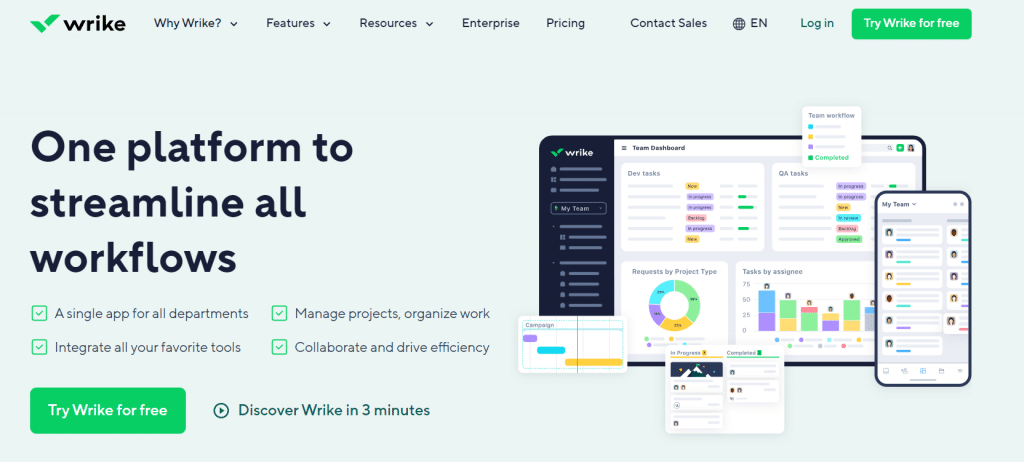
Wrike is a cloud-based project management tool that assists teams in planning, executing, and completing projects. It offers a broad range of capabilities, including task administration, group collaboration, real-time updates, file sharing, and time tracking. The platform provides a centralized workspace where team members can work together, share files, and communicate instantly.
Wrike also has tools for project planning and construction scheduling software solutions, such as Gantt charts, calendars, and timelines. Project management teams can see the progress of a project, making it easier to monitor and manage tasks and deadlines. Moreover, Wrike integrates with widely used tools like Google Drive, Slack, and Microsoft Teams, making it convenient for teams to collaborate and access required information.
In conclusion, Wrike is a complete solution for project management and collaboration, suitable for teams of all sizes and various industries. Its aim is to help teams work more efficiently, enhance productivity, and enhance project completion.
Pros
- Intuitive interface: Wrike features an intuitive interface that makes it easy for users, even beginners in project management software, to use and navigate.
- Real-time collaboration: The platform also provides real-time collaboration capabilities, enabling teams to work and share information in real time.
- Task administration: Wrike has robust task management tools, making it straightforward to create, assign, and manage tasks, establish deadlines, and monitor progress.
- Integration with other tools: Wrike integrates with well-known tools such as Google Drive, Slack, and Microsoft Teams, making it simpler for teams to work together and access needed information.
- Reporting and data analysis: Wrike offers reporting and data analysis tools, enabling teams to see the progress of their projects and make informed decisions.
Cons
- Steep learning curve: Wrike has numerous features, and some users may find it difficult to learn and master all of them.
- Limited customization: While Wrike’s interface and tools are designed to be user-friendly, this may limit users’ ability to customize the platform to meet their unique needs.
- Cost: Wrike is a subscription-based service, and its cost can be a significant investment for smaller teams or organizations.
- Limited offline capabilities: Wrike is a cloud-based platform, and some users may find that their ability to use the platform offline is limited.
- Technical issues: Wrike relies on technology, and users may encounter technical problems that affect their ability to effectively use the platform.
Pricing
Wrike offers a range of pricing plans for individuals and teams of all sizes. It has a free plan for individual users and small teams, as well as a range of paid plans that offer more features and capabilities.
The paid plans are divided into the following categories: Team, Business, Enterprise and Pinnacle. The Team plan starts at $9.80 per user per month, when billed annually. The Business plan starts at $24.80 per user per month, when billed annually, the Enterprise plan is priced on a case-by-case basis and the Pinnacle plan is for complex work needs and includes advanced tools.
Wrike also offers a Free plan, allowing users to try out the platform and its features before committing to a paid plan.This is mainly for teams that are getting started. The pricing plans are scalable and can be adjusted to accommodate the changing needs of a team or organization.
Assignar
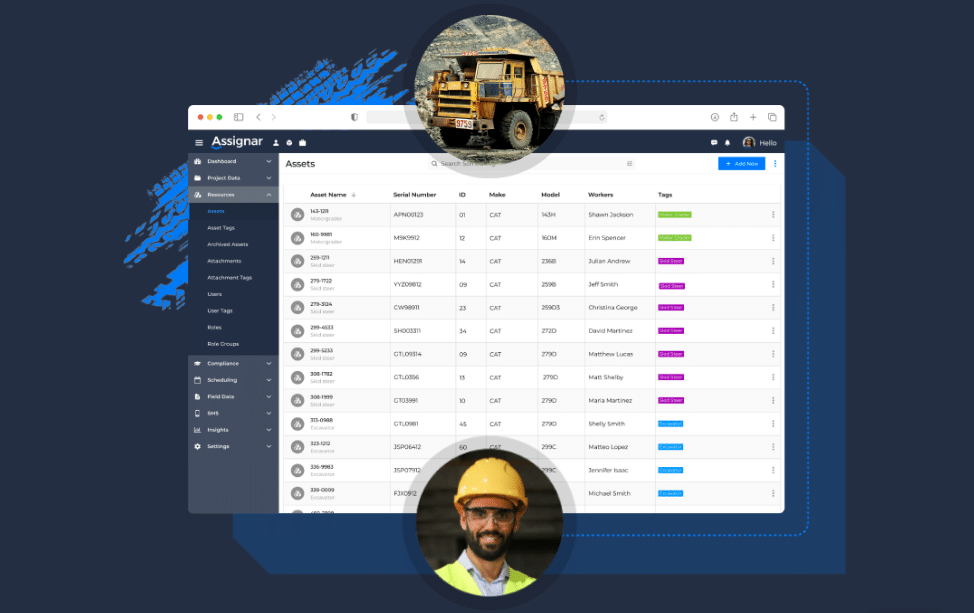
Assignar is a cloud-based construction scheduling software platform designed to help organizations manage their operations and workforces more efficiently. It provides a range of tools and features that help companies to schedule resources, manage projects, track time and expenses, and communicate with their teams.
It is suitable for use in various industries, including construction, field service, and maintenance. With Assignar, companies can streamline their work processes, increase productivity, and improve the coordination and communication of their teams.
Pros
- Improved visibility: Assignar provides a centralized platform for managing projects and work processes, which helps organizations to have a better overview of their operations.
- Increased efficiency: With features such as resource scheduling, time tracking, and expense management, Assignar helps companies to streamline their work processes and save time.
- Better communication: Assignar provides tools for communication and collaboration between team members, which helps to improve the coordination of projects and reduce the likelihood of mistakes.
- Easy to use: Assignar is user-friendly and easy to set up, making it accessible for organizations of all sizes.
Cons
- Dependence on internet connection: Assignar is a cloud-based tool, so it requires a stable internet connection to work properly.
- Limited customization options: While Assignar offers a range of features, some users may find that they need more customization options to meet their specific requirements.
- Potential for data security concerns: As with any cloud-based software, there may be concerns about data security and privacy. It’s important for organizations to assess their security needs and make sure that Assignar’s security measures are sufficient for their needs.
- Subscription cost: Using Assignar requires a monthly or annual subscription, which may not be affordable for all organizations.
Pricing
Assignar pricing is based on a monthly or annual subscription model, with different pricing tiers that depend on the features and capabilities required by the organization.
Typically, Assignar offers several pricing plans, including a basic plan that provides access to the essential features, as well as more advanced plans that offer additional functionality.
The cost of an Assignar subscription will depend on factors such as the number of users, the size of the organization, and the specific features that are required. In general, the more advanced plans tend to be more expensive than the basic plans, but they offer more capabilities and greater scalability.
Jobber

Jobber is a cloud-based field service management software designed to help businesses manage their operations and workforces more efficiently. It provides a range of tools and features that help companies to schedule jobs, manage projects, track time and expenses, and communicate with their teams.
Jobber is suitable for use in various industries, including home services, cleaning and landscaping, and maintenance. With Jobber, companies can streamline their work processes, increase productivity, and improve the coordination and communication of their teams.
Jobber offers features such as job scheduling and dispatch, invoicing and payment processing, and reporting and analytics. It also provides a mobile app for use by field technicians, allowing them to access job information, record time and expenses, and communicate with their teams while on the go.
Pros
- Improved efficiency: Jobber provides tools similar to those of construction scheduling software, dispatch, and time tracking, which helps organizations to streamline their work processes and save time.
- Better communication: Jobber provides features for communication and collaboration between team members, which helps to improve the coordination of projects and reduce the likelihood of mistakes.
- Mobile accessibility: Jobber provides a mobile app for use by field technicians, which allows them to access job information, record time and expenses, and communicate with their teams while on the go.
- Comprehensive reporting: Jobber provides a range of reporting and analytics tools that help organizations to track their performance, monitor costs, and identify areas for improvement.
Cons
- Limited customization options: While Jobber offers a range of features, some users may find that they need more customization options to meet their specific requirements.
- Potential for data security concerns: As with any cloud-based software, there may be concerns about data security and privacy. It’s important for organizations to assess their security needs and make sure that Jobber’s security measures are sufficient for their needs.
- Subscription cost: Using Jobber requires a monthly or annual subscription, which may not be affordable for all organizations.
Pricing
Jobber offers four types of pricing options that include the Lite plan which is $19 per month, providing new businesses with quoting, invoicing, and payments. It also offers a Core plan that is $49 per month that allows users to organize their operations from quoting to scheduling to invoicing all in one place. Then, there is a Connect plan which is $129 per month and helps build efficient processes that better connect team and impress customers. Finally, there is a Grow plan which is crafted for up to 15 people and starts at $249 per month. This one allows scaling business with powerful sales and marketing automation.
Float
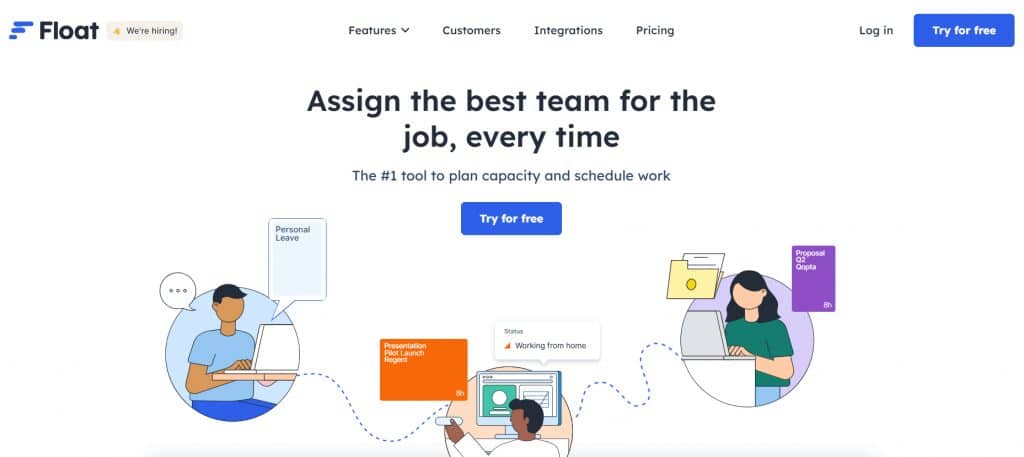
Float is a project management and resource planning tool designed to help organizations optimize their workflow and allocate their resources more effectively. It provides a range of tools and features that help teams to schedule projects, manage tasks, and track progress, as well as to monitor their workloads and identify areas for improvement.
Float is suitable for use by teams in a variety of industries, including digital agencies, marketing teams, and software development companies. With Float, teams can visualize their work, identify areas of over- or under-capacity, and make informed decisions about how to allocate their resources.
Some of the key features of Float include project and task management, resource planning, workload visualization, and time tracking. It also provides a range of reporting and analytics tools that help teams to track their progress and monitor their workloads.
Pros
- Improved resource management: Float provides a range of tools and features that help organizations to allocate their resources more effectively and monitor their workloads, which can improve productivity and efficiency.
- Project visibility: Float provides a visual representation of projects and tasks, which helps teams to better understand their progress and identify areas for improvement.
- Time tracking: Float provides time tracking features that help organizations to monitor the time spent on projects and tasks, which can help to reduce waste and increase efficiency.
- Collaboration: Float provides tools for collaboration and communication between team members, which can help to improve coordination and reduce the likelihood of mistakes.
Cons
- Dependence on internet connection: Float is a cloud-based tool, so it requires a stable internet connection to work properly.
- Limited customization options: While Float offers a range of features, some users may find that they need more customization options to meet their specific requirements.
- Potential for data security concerns: As with any cloud-based software, there may be concerns about data security and privacy. It’s important for organizations to assess their security needs and make sure that Float’s security measures are sufficient for their needs.
- Subscription cost: Using Float requires a monthly or annual subscription, which may not be affordable for all organizations.
Pricing
Float mainly includes two pricing plans:
Resource planning which is $6 per person per month and Resource planning plus Time tracking which is $10 per person per month. There is also an add-on which is an additional $6 per person per month which includes an assigned account manager, custom contract, domain restrictions, prioritized support, single sign-on (SSO), and an advanced activity log. These prices are 20% cheaper if you choose to pay on an annual basis.
Final Thoughts on Choosing Construction Scheduling Software
The right construction scheduling software should give you a clear overview of project timelines, allow you to set task dependencies, track progress in real time, and integrate smoothly with budgeting, estimating, and document management tools. Such capabilities will prevent delays and also improve collaboration and resource planning across the entire project lifecycle.
For teams that want all of these capabilities in a single platform, Buildern offers an option worth exploring.
If you’re looking for a comprehensive solution to streamline your construction project management, consider giving Buildern a try. Sign up now to experience the benefits of an all-in-one solution for your construction business.

